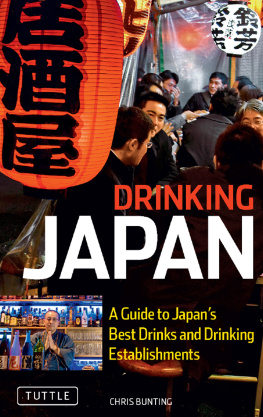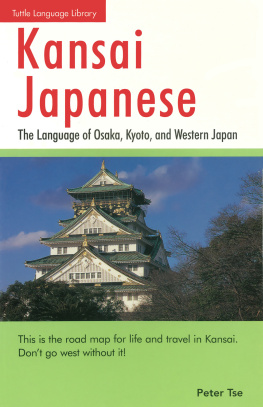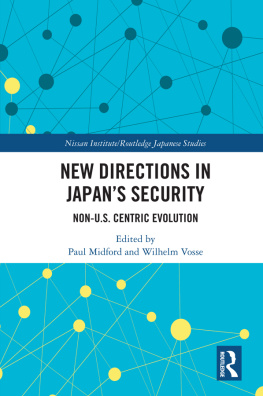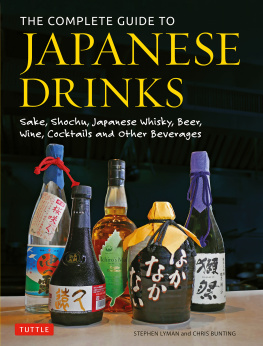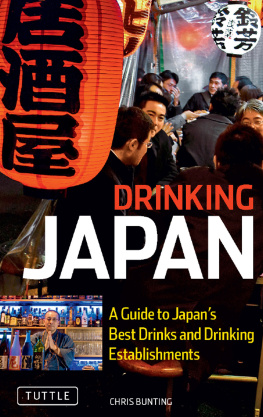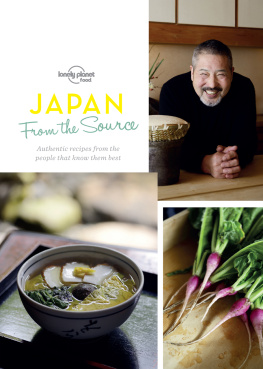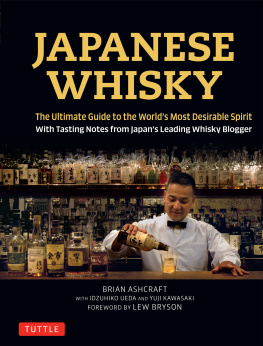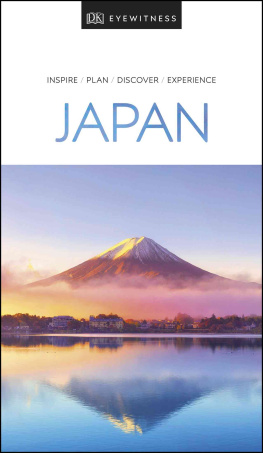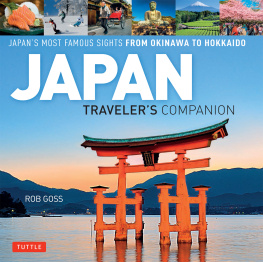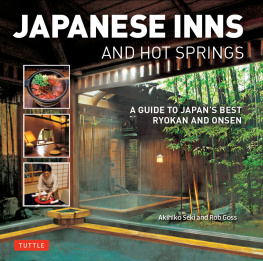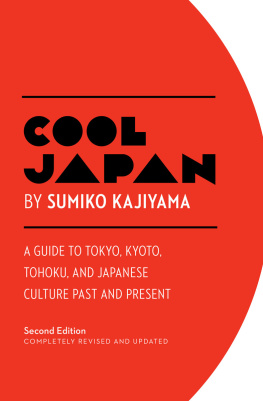Acknowledgments
I could not have written this book without the help of Itsuo Yoshino and Ayako Yoshino. Every word in these pages is the product of a group effort. I would like to thank them both for the weeks they spent helping me research in a language that is not my own. I would also like to thank Mitsue Yoshino for providing unstinting moral and practical support. The emotional space and encouragement given to me by my parents, Paul and Judith Bunting, allowed me to pursue this crooked, crazy career path of mine. Their eagle eyes spotted dozens of errors in my drafts.
Lee Yuen Kuan and Loh Sook Fan at Tuttle Publishing molded those drafts into what I think is both a visually stunning and functional book design. They showed extraordinary patience in dealing with my endless footering with the text. Tuttles cartographers Fajar Wisnu Hardono and Amin Cahyadi created all the maps in the book. Noor Azlina Yunus edited the manuscript with an exceedingly sharp pen, succeeded in the daunting task of changing my British English into US English and somehow managed not to be sent round the bend by my last-minute changes. I would also like to thank June Chong in Tuttles Singapore office, who dragged Drinking Japan over the finish line, and Eric Oey, my publisher, who honed my original concept for the book into this guidebook and gave me unwavering support.
The beer chapter of this guide was helped immeasurably by Chris Chuwy Philips, who was the source for almost everything I wrote about contemporary Japanese craft beer. Taylor Smisson opened my eyes to the richness of Japanese bar culture. Takeshi Mogi taught me about Japanese whisky (though he claims he did not!). Phred Kaufman showed me Sapporo and gave me a thundering hangover. John Davis and Akiyoshi Miyagi took me around Okinawa. The folks at Tsukayama, Helios and Zuisen distilleries gave me a privileged look at awamori making. Yusaku Takenouchi at Shirakane distillery and Toshihiro Manzen at Manzen distillery showed me craft shch distilling at its best. Serge Valentin, Davin de Kergommeaux, Dave Broom, Marcin Miller and Nicholas Sikorski-Mazur taught me about whisky and distilled spirits. Denis Gastin helped me get my head around Japanese wine.
At Suntory Holdings Ltd, Aoi Kojima was tireless and her ability to communicate in English was a great boon. Kazumasa Nishizaki, Hiroyoshi Miyamoto, Seiichi Koshimizu and Makoto Sumita all took time out of very busy schedules to show me around Suntorys facilities. At Asahi, Aiko Shima was extremely helpful, and the staff at the Yoichi and Miyagiky distilleries could not have been more welcoming. I would particularly like to thank Minoru Miake at Miyagiky and Koichi Nishikawa and Inoru Kohara at Yoichi. Mikio Hiraishi, president of Eigashima Shuz, spent hours with me at the White Oak whisky distillery. Eri Todokoro at Kirin Brewery Ltd, Shigeharu Asagiri at Coedo Ltd and Kazue Matsushima at Fuji Kank Kaihatsu also provided crucial assistance.
I visited hundreds of bars while researching this guide. Almost everyone was incredibly welcoming. There are too many people to thank individually but, of course, this book would not exist without them. Numerous bars did not, in the end, make it into the guide. I would like to apologize to their owners and staff, who spent time answering my questions and allowing me to take photographs of their establishments.
As my book began to take shape, Brian Harrell, John Gauntner and www.tokyofoodcast.coms Et-chan and Te-chan gave expert guidance, rooting out numerous errors in my early drafts. Nicholas Coldicott at the Japan Times provided much-needed perspective and nuance to my ideas about the Japanese drinks scene and shared his compendious knowledge of Tkys bars.
APPENDIX
Speaking Bar Japanese
Taking the plunge into Japanese alcohol culture can take a little bit of courage, especially for those who do not speak Japanese fluently. It is always going to be easier to play it safe and order a Budweiser from the hotel bar than to venture out into the back streets and start pushing your nose into unfamiliar drinking holes serving unfamiliar drinks. In many moods, I go for the Budweiser and the quiet life, and there are hotel bars and bars catering specifically to foreigners in this guide. Some of them are great. Nevertheless, it is nice at least to have the option of doing something different, and I am convinced that even someone who is completely ignorant of the Japanese language can enjoy the best of Japans bars and drinks with relative ease.
Learning Japanese is a bit like climbing Mount Fuji. The higher you go, the steeper it gets. This is good news for the beginner, because basic Japanese pronunciation is not difficult and beginners grammar is also fairly straightforward. The third big factor in the novices favor is that the majority of Japanese people are very supportive of people giving their language a try.
Thats the good news. The bad news is that Japanese is one of the hardest written languages in the world to master. There are two phonetic syllabaries with 45 characters each hiragana and katakana (often used for foreign words)and much of the meaning in any sentence (or on any bottle label) is carried by fiendishly difficult kanji ideograms. There are thousands of these to be learned by rote and no prospect of teaching this writing system for the purposes of this book. But who cares? Whoever said you needed to be able to understand everything around you to enjoy a drink at a bar? I have divided this chapter into two sectionsVisiting Japanese bars and Shopping for alcohol. They provide some basic spoken phrases and written language that should take you a surprisingly long way into Japanese alcohol culture. But first, two important preliminaries Japanese pronunciation and counting.
Pronunciation
Basic Japanese pronunciation is not very complicated. It is a good general principle to try to pronounce all syllables with equal stress. English speakers tend to put stress on particular parts of words. Japanese speakers tend to give each syllable equal stress.
There are five basic vowel sounds. There is a difficulty in trying to find reliable analogues in English, because English dialects differ so greatly in their pronunciation, but here is my best shot:
a to rhyme with the first syllable of cattle for an Englishman. Many North Americans might describe this as somewhere between the a in father and the a in Dad. (International Phonetic Alphabet (IPA): ( a )
i to rhyme with the first syllable of fiddle or feet. (International Phonetic Alphabet (IPA): ( i )
u to rhyme with who, or true or the first syllable of cruel. (International Phonetic Alphabet (IPA): ( )
e as in pen or bed. (International Phonetic Alphabet (IPA): ( e )
o as in not for an Englishman. Many English speakers lengthen the pronunciation of o . The Japanese o is pronounced with minimal mouth movement. (International Phonetic Alphabet (IPA): ( o )
These are combined with consonants ka , ki , ku , ke , ko or na , ni , nu , ne , no , etc.but the pronunciation of the vowel component remains constant. Japanese has a strict syllable system similar to Italian and, indeed, the five basic Japanese vowel sounds are quite close to their basic Italian equivalents. There are also some elongated vowel sounds, which I have transcribed in this book with an accent ( , ). These are best regarded by the beginner as slightly longer pronunciations of the basic vowel sound (for instance, to rhyme with flow or hoe or oh in my British English.) There are, of course, plenty of complications (many language teachers will be pulling their hair out at my oversimplifications) but the only ones I am going to mention here are three additional long vowel sounds:
ei as in day
ai as in lieor fly
au as in out or Ow!

